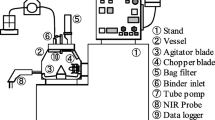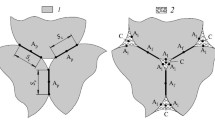Abstract
Suitable water content plays a decisive role in the granulation of sintering mixtures. Herein, a method was proposed to predict the suitable water content for effective granulation on the basis of Litster’s granulation model. The granulation effectiveness of a sintering mixture was predicted by the model, with the allowance error of ± 10%. The effects of the water absorption properties, particle size composition and content of adhesive particles on the suitable water content were studied. The results showed that the allowable error of prediction was within ± 0.5% compared to the experimentally determined suitable water content. With an increase in adhesive powder content of mixtures with higher water absorption, the suitable water content increased to achieve similar granulation effectiveness. Moreover, as the amount of concentrates increased, the suitable water content first increased and then remained steady. The influence of the water absorption characteristics of the adhesive particles on the suitable water content was less than that of their particle size composition in the mixture.





Similar content being viewed by others
References
S.S. Bureau, Steel statistical yearbook, World Steel Association, Belgium, Brussels, 2021.
L. Zhu, F. He, Appl. Math. Model. 103 (2022) 162–175.
J. Fu, T. Jiang, Sintering pelletology, Central South University of Technology Press, Changsha, China, 1996.
T. Liu, Q.Y. Zhang, J.H. Sheng, Y.W. Jiang, B.W. Wang, Y.L. Song, Sinter. Pelletiz. 45 (2020) No. 3, 17–21.
D. Fernández-González, I. Ruiz-Bustinza, J. Mochón, C. González-Gasca, L.F. Verdeja, Miner. Process. Extr. Metall. Rev. 38 (2017) 36–46.
S.M. Iveson, J.D. Litster, K. Hapgood, B.J. Ennis, Powder Technol. 117 (2001) 3–39.
X. Fan, Principle and technology of iron ore matching for sintering, Metallurgical Industry Press, Beijing, China, 2013.
H. Takasaki, E. Yonemochi, R. Messerschmid, M. Ito, K. Wada, K. Terada, Int. J. Pharm. 456 (2013) 58–64.
S. Kawachi, S. Kasama, Tetsu-to-Hagane 94 (2008) 475–482.
M. Gan, X.H. Fan, Z.Y. Ji, X.L. Chen, L. Yin, T. Jiang, Z.Y. Yu, Y.S. Huang, Ironmak. Steelmak. 42 (2015) 351–357.
T. Maeda, C. Fukumoto, T. Matsumura, K. Nishioka, M. Shimizu, ISIJ Int. 45 (2005) 477–484.
J. Khosa, J. Manuel, ISIJ Int. 47 (2007) 965–972.
M. Matsumura, T. Kawaguchi, Tetsu-to-Hagane 87 (2001) 290–297.
R. Marín Rivera, A. Koltsov, B. Araya Lazcano, J.F. Douce, Int. J. Miner. Process. 162 (2017) 36–47.
X.H. Fan, M. Gan, W.Q. Li, Q. Wang, L.B. Xie, L. Hu, X.L. Chen, L.S. Yuan, J. Univ. Sci. Technol. Beijing 34 (2012) 373–377.
L.F. Chen, M. Wu, W.H. Cao, X.Z. Lai, Computers and Applied Chemistry 28 (2011) 816–820.
S.L. Wu, J.X. Fan, J. Zhu, J.C. Bei, Z.G. Que, J. Iron Steel Res. 27 (2015) No. 1, 27–34.
G.L. Zhang, S.L. Wu, J. Zhu, Y.Z. Wang, Int. J. Miner. Metall. Mater. 21 (2014) 122–130.
X. Lv, C. Bai, G. Qiu, S. Zhang, M. Hu, ISIJ Int. 50 (2010) 695–701.
L. Zhou, Shandong Metallurgy 43 (2021) No. 2, 30–32.
Y.Q. Ren, C.Q. Huang, Y.S. Jiang, Z.X. Wu, Metals 12 (2022) 1287.
H.Y. Cai, Intelligent control and research of self-learning model in sinter mixture moisture, Northeastern University, Shenyang, China, 2017.
Y.M. Wu, H.Y. Nie, C.X. Wu, Metallurgical Industry Automation 45 (2021) No. 1, 27–33.
Y.S. Jiang, N. Yang, Q.Q. Yao, Z.X. Wu, W. Jin, Neurocomputing 396 (2020) 209–215.
C. Yang, D. Zhu, J. Pan, L. Lu, ISIJ Int. 58 (2018) 1427–1436.
J.D. Litster, A.G. Waters, Powder Technol. 55 (1988) 141–151.
Acknowledgements
This work is supported in part by the National Natural Science Foundation of China under Grant No. 51804347.
Author information
Authors and Affiliations
Corresponding authors
Ethics declarations
Conflict of interest
Zhi-yun Ji is an youth editorial board member for Journal of Iron and Steel Research International and was not involved in the editorial review or the decision to publish this article. All authors declare that there are no competing interests. The authors have no potential conflict of interest to report.
Appendix
Appendix
1.1 Calculation flow of average particle size of granules
For a given ore blending condition, \({x}_{0.5}\) can be obtained according to Eq. (6). Then, α(\(x\)) can be calculated by \({x}_{0.5}\) in Eq. (2). Based on the Litster’s granulation model, the calculation flow is as follows.
The ratio of layer mass to nuclei mass of granules in ith size, \({R}_{i}\), is shown in following formula:
where n is the total particle size number; αi is the partition coefficient of the particles with ith size; and ωik is the mass fraction of component k in ith size.
The mass fraction of granules in ith size, \({\omega }_{\mathrm{g}i}\) (%) is depicted in Eq. (8):
The adhering layer thickness of granules in ith size (d–dl grain size), \({\varDelta }_{i}\), in mm, is described in Eq. (9):
The top size of granule in ith size, \({x}_{i}\), in mm, can be calculated as follows:
Finally, the average particle size of granules, \(\overline{d}\), in mm, can be obtained from Eq. (11):
Rights and permissions
Springer Nature or its licensor (e.g. a society or other partner) holds exclusive rights to this article under a publishing agreement with the author(s) or other rightsholder(s); author self-archiving of the accepted manuscript version of this article is solely governed by the terms of such publishing agreement and applicable law.
About this article
Cite this article
Dai, Fl., Fan, Xh., Huang, Xx. et al. Prediction of suitable water content in granulation of sintering mixture based on Litster’s model. J. Iron Steel Res. Int. 31, 552–560 (2024). https://doi.org/10.1007/s42243-023-01089-y
Received:
Revised:
Accepted:
Published:
Issue Date:
DOI: https://doi.org/10.1007/s42243-023-01089-y




